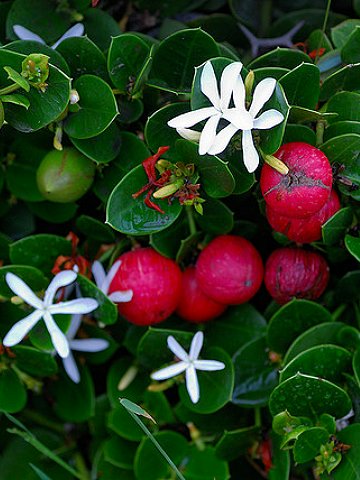
|
|
Natal Plum (Carissa macrocarpa).
Flowers and fruits.
|
Natal Plum - Carissa macrocarpalla
Carissa macrocarpa (Natal Plum), is a shrub native to South
Africa, where it is commonly called the Large Num-Num. In Zulu, as well as in the Bantu tribes of
Uganda, it is called Amathungulu or umThungulu oBomvu. In Afrikaans the fruit is called
Noem-Noem.
Carissa macrocarpa is a fast-growing, ornamental shrub that is
salt-laden wind resistant and can grow in coastal areas.
It usually forms a dense thorny shrub but it can grow into a small tree up to 4 m
high. This species has Y- shaped thorns; the young branches are green and all parts of the plant exude a
white, milky, non-toxic latex. Leaves are leathery, a shiny dark green above and paler
below, 20-60 x 15-35 mm, egg-shaped, oval or almost round. The tips of the leaves are sharply or bluntly pointed and usually with a
mucro, a thorn-like point. The flowers vary in size, up to 35 mm in diameter, are pure white and scented like orange
blossom. The flower tube is hairy within. It flowers from spring to midsummer.
The ornamental plump, round, crimson fruit appears in summer and fall
(autumn) at the same time as the blooms. In moderate, coastal areas the fruits appear through the
year. The large, oval red fruit is edible and is rich in Vitamin C, magnesium and
phosphorus. The fruit can be eaten out of hand or made into pies, jams, jellies, and
sauces.
Some claim that other than the fruit, the plant is
poisonous. However this claim is a myth, possibly based on similarities to other plants with milky
sap.
A traditional food plant in Africa, this
little-known fruit has potential to improve nutrition, boost food security, foster rural development and support sustainable
landcare.
Carissa macrocarpa grows mainly in coastal areas in South
Africa. It can be found on sand dunes and on the edges of coastal forests in Eastern Cape Province northwards from Natal to
Mozambique. Today the plant is also growing commonly in southern Florida and is cultivated in southern California and used widely as an ornamental in Central America and the
Caribbean.
The name Carissa is derived from the Sanskrit
corissa, the name of one of the Indian species. The specific name macrocarpa is derived from Greek words for
'large' and 'fruit'. The common name amatungulu is the Zulu name amaTungula meaning
'fruit of the umThungula'.
This ornamental shrub attracts birds and butterflies to the garden
and makes a good garden hedge.Plant one metre apart to form a dense, impenetrable hedge in full sun to
semi-shade in good garden soil, enriched with compost. It can be pruned if
necessary. It is best grown from seed, but can also be grown from cuttings. Carissa macrocarpa will produce fruits within the first 2 years
after planting.
The plant moulds itself very well to bending and for this reason can be grown as a very attractive Bonsai
plant.
A low growing form of C. macrocarpa, "Green
carpet" is a popular groundcover plant which seldom grows more than knee
height.
Source:
https://en.wikipedia.org/wiki/Carissa_macrocarpa
https://www.plantzafrica.com/plantcd/carismac.htm
